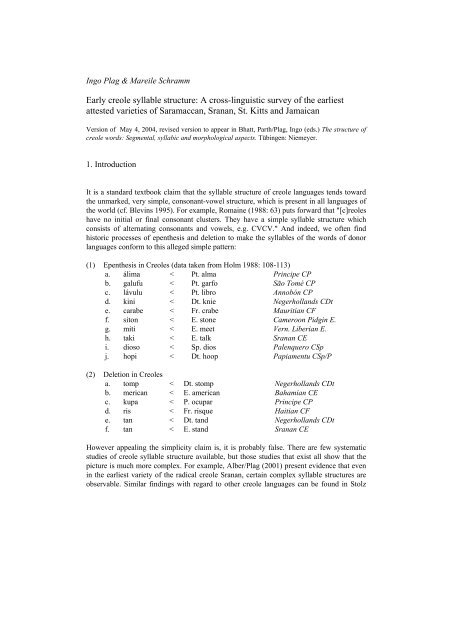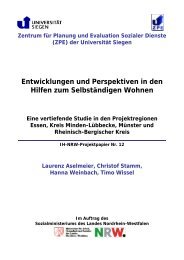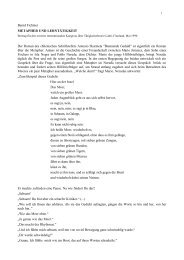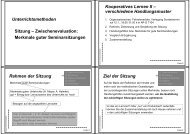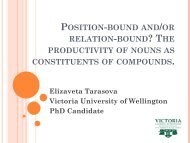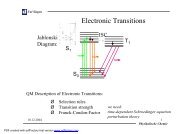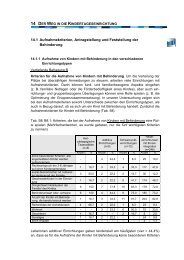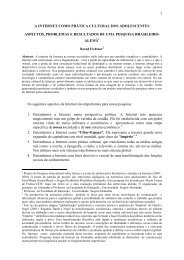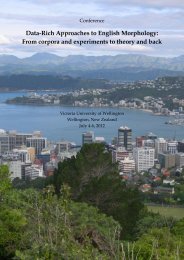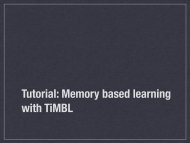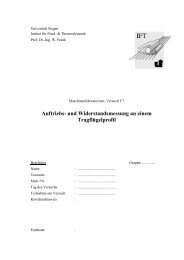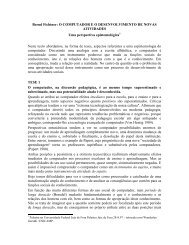Early creole syllable structure: evidence from early varieties
Early creole syllable structure: evidence from early varieties
Early creole syllable structure: evidence from early varieties
Create successful ePaper yourself
Turn your PDF publications into a flip-book with our unique Google optimized e-Paper software.
4 Ingo Plag and Mareile Schrammthe texts that had sufficient length and were rated highest made it into our corpus, whichfinally consisted of 1036 word types. A list of the selected texts can be found in theappendix.All sources show a certain amount of variation, with the <strong>Early</strong> Jamaican text being moststriking in this respect. Of course, one could argue that this variation is due toinconsistencies in the notation of the source texts. However, as we selected only those <strong>Early</strong>Jamaican texts which appeared most reliable, we should not expect this factor to influencethe quality of the corpus to great measures. Another explanation for the variability could bethat it was actually a prevalent feature of <strong>Early</strong> Jamaican. This does not seem unlikely,considering what we find in the modern variety of the <strong>creole</strong>. In 1961, DeCamp referred tothe linguistic situation in Jamaica as one of a continuum, “ranging <strong>from</strong> the speech of themost backward peasant labourer all the way to that of the well-educated urban professional”(1961: 82). Likewise, in a more recent study, Patrick (1999) finds that speakers of JamaicanCreole differ considerably in their linguistic performance. The high degree of variation thusappears to be a general characteristic of Jamaican <strong>from</strong> <strong>early</strong> on.All source texts were first digitalized, then word lists were created and each word typewas coded in an electronic database for the relevant phonological properties. For ouranalysis we concentrated on the clear majority patterns found in the <strong>creole</strong> data, mostlyexcluding isolated variants <strong>from</strong> the discussion. 3 However, in those cases where thevariability is substantial in a particular context, it was included in the analysis. Where thevariation is intriguing for some other reason, we comment on it in the relevant sections.The results of our investigation are described in the next section. 43. ResultsIn this section we will first take a look at complex onsets, then turn to word-final codas andfinally to word-internal consonant clusters. It will become clear that there is a substantialoverlap in the patterns of all four <strong>varieties</strong>, but there are also considerable differences, withthe Surinamese <strong>creole</strong>s patterning differently <strong>from</strong> the island <strong>creole</strong>s.3.1. Complex OnsetsWith regard to onset <strong>structure</strong>s we observe a striking similarity between the four <strong>creole</strong>languages. All of them allow complex onsets consisting of two consonants, provided thatthese onsets obey the sonority principle (e.g. Clements 1990). Thus, different kinds ofword-initial obstruent-sonorant clusters are possible and attested:3 But see, for example, Plag and Uffmann (2000) for a detailed quantitative analysis of deletion andepenthesis in <strong>Early</strong> Sranan sources.4 Initial exploratory studies of <strong>Early</strong> Saramaccan, <strong>Early</strong> St. Kitts and <strong>Early</strong> Jamaican were carried outby Rotter (2002), Schüttenhelm (2002) and Schramm (2003). The analysis of <strong>Early</strong> Sranan is taken<strong>from</strong> Alber/Plag (2001).
<strong>Early</strong> <strong>creole</strong> <strong>syllable</strong> <strong>structure</strong> 5(4) English <strong>creole</strong>a. snake > sneki ESRSuriname > Srananbrake > brekib. afraid > frede ESAself > srepismoke > smokoc. broke > bruk ESKsleep > sleepsweet > sweetd. truth > trut EJAM 5swim > swimsmall > smallIf, however, the initial cluster violates sonority, as the /s-plosive/ clusters do in English,these clusters are uniformly repaired in all four <strong>creole</strong> <strong>varieties</strong> by deletion of the firstconsonant, i.e. /s/. Consider the data in (5) through (8):(5) English ESRa. speak > pikistand > tanstrong > trangascrape > krebisquare > kwerib. speak > *sipiki, *sikistrong > *sitaranga, *srangac. smoke > smoko (*somoko, *moko, *soko)snake > sneki (*sineki, *neki, *seki)d. sleep > slibi/sribi (*silibi, *sibi, *libi)drink > dringi (*diringi, *ringi, *dingi)(6) English ESAa. speak > pikkisteer > tîristrong > trangascratch > krassib. speak > *sipikki, *sikkistrong > *sitaranga, *srangac. smoke > smoko (*somoko, *moko, *soko)snake > sneki (*sineki, *neki, *seki)d. bless > blessi (*bilessi, *lessi, *bessi)drink > dringi (*diringi, *ringi, *dingi)5 Note that in EJAM there are some isolated forms in which the second consonant, usually an /r/ or an/l/, is deleted (e.g. blaspheme > b’apheme).
6 Ingo Plag and Mareile Schramm(7) English ESKa. spit > pitstand > tanskin > kinb. skin > *sikin, *sinc. smoke > no <strong>evidence</strong>; probably retentionsnake > no <strong>evidence</strong>; probably retentiond. sleep > sleep (*leep, *seep)play > play (*lay, *pay)quarter > quatter (*watter, *katter)(8) English EJAMa. speak > peakstand > tanskin > kinb. skin > *sikin, *sinc. small > small (*mall, *sall)d. sleep > sleep (*leep, *seep)crab > crab (*rab, *cab )twenty > twenty (*wenty, *tenty)The asterisked forms in the (a) and (b) cases of (5) through (8) show that alternative optionsto repair an offending cluster, such as deletion of the second consonant or epenthesis of avowel, are systematically ruled out. The forms in (c) and (d), illustrate that for sonorityobeyingclusters no reduced forms are attested, they are never repaired.2.2. Word-final codasWith regard to word-final codas, we can see a split between the two Surinames <strong>varieties</strong>and the two <strong>varieties</strong> spoken on the island. While both ESR and ESA - with one notableexception - only allow simplex nasal codas, ESK and EJAM tolerate also other codaconsonants. Let us consider ESR and ESA first. The data in (9) and (10) show that wordfinalcodas in these languages are being repaired by vowel epenthesis, unless the codaconsonant is a nasal (see (9a) and (10a)). 6 Deletion of a final singleton consonant is not anoption, as illustrated by the asterisked forms in (9b) and (10b). In the case of a finalconsonant cluster, it can be additionally observed that the stem-final consonant is deleted,unless it is preceded by a nasal. In such cases, we get a an output <strong>structure</strong> that againconforms to the overall coda restriction (cf. (9c), (9d), (10c) and (10d)).(9) English ESAa. one > wan (*wa, *wani)begin > begin (*begi, *begini)6 We do not discuss here the problem of which vowel is inserted in each particular case. SeePlag/Uffmann (2001), Lappe/Plag (2003) or (Uffmann) 2004 for recent treatments.
<strong>Early</strong> <strong>creole</strong> <strong>syllable</strong> <strong>structure</strong> 9(17) Engl./Port. ESAnasty > nâsibastard > bassrasoftly > safri, sapri(18) English ESRdoctor > datranasty > nasisoftly > safrisister > sisaIt is not quite clear what determines the choice of the deleted consonant. According toWilson (2001:148), phonological processes of cluster reduction by deletion canonicallytarget the first consonant. This means that the data in (17) and (18) above (with theexception of datra < doctor) would call for a refinement (or even abandonment) of thisputative typological generalization. Taking into account data such as those in (19) rathersuggests an analysis on the basis of sonority. It is the least sonorous consonant that isdeleted:(19) a. English ESAgoodmorrow > gumarragoodnight > gunêtib. English > ESRgoodmorrow > kumaragoodnight > kunetiOnly in those cases where sonority cannot decide (such as doctor > datra), it is the firstconsonant that has to be deleted, in accordance with Wilson’s generalization. The sonoritybasedargumentation is, however, only convincing if we accept the idea that plosives areless sonorant than fricatives (cf. nasty > nasi), and that the /d/ in expressions such as goodmorrow and good night was still present in the input to the restructuring process.ESK and EJAM show partly an identical, and partly a different pattern. They both allowinternal nasal-obstruent(-sonorant) clusters under the appropriate syllabification, as<strong>evidence</strong>d in (20):(20) English ESKsomebody > somebodysomething > suntinghungry > (h)ungry(21) English EJAMmpempem (Twi) > pempeny ‘plenty’something > suntingmaster-thank you > massa-tenky
10 Ingo Plag and Mareile SchrammWith other internal clusters, we find two patterns, deletion and preservation. In the casessuch as those in (22a) and (23a), we find deletion of the first consonant, in the cases in(22b) and (23b) deletion of the second consonant.(22) English ESKa. business > binnessb. mister > missynasty > nasy(23) English EJAMa. blaspheme > baphemeb. master > massaSo far, everything looks parallel to the Surinamese <strong>creole</strong>s, to the effect that word-internal,codas are not allowed in EJAM and ESK, although word-finally, codas are legal.However, ESK and EJAM also variably show the preservation of internal clusters, whichleads to the existence of word-internal codas. Consider (24):(24) a. English ESKsister > sissy, sisterb. English EJAMminister > ministerIn ESK this is the minority pattern, in EJAM this is the majority pattern. The variation itselfand the comparison with the other two <strong>varieties</strong> suggests that we are dealing with twodifferent stages of development. We propose that in an earlier stage of the language, therewere no internal codas. Due to new words entering the language which were adopted with amore faithful rendering of the original segmental sequence, internal coda consonantsbecame possible. This process is more advanced for EJAM than for ESK at the time of therespective documentary <strong>evidence</strong>. An additional fact speaking in favor of our proposal isthat the variation at least in Jamaican appears to operate on a item-by-item basis, such thatthere is no lexical item that shows both variants. This is exactly what you would expect inthis type of change. Furthermore, it is the presumably older, and more frequent, every-daywords (such as master or sister) that show consistent deletion.To wrap up the story of internal clusters, we can say that complex onsets which areallowed in initial position can occur word-internally as well (e.g. Saramaccan: kondre
<strong>Early</strong> <strong>creole</strong> <strong>syllable</strong> <strong>structure</strong> 112.4. SummaryIn (25) we have summarized the main results of our analysis, giving both the possible<strong>structure</strong>s (indicated by ‘yes’), and the pertinent repair strategies (‘T’ stands for /d/ and /t/):(25) Summary of <strong>syllable</strong> <strong>structure</strong>s and repair strategiesESR/ESAESK/EJAMcomplex onsets:[obstr] [son] yes yes/sP/ deletion of /s/ deletion of /s/word-final codas:nasal coda yes yesnon-nasal coda epenthesis ⇒ .CV# yesNC coda epenthesis ⇒ N.CV# - yes, if C ≠ TC 1 C 2 codadeletion of C 2 and epenthesis⇒ .C 1 V#- deletion of C, if C = T ⇒ N#deletion of C 2 ⇒ C 1 #internal clusters:NC(C) yes ⇒ N.C(C) yes ⇒ N.C(C)C 1 C 2 deletion of C 1 or C 2 variable deletion of C 1 or C 2The table shows nicely the similarities and differences between the different <strong>varieties</strong>, withthe island <strong>creole</strong>s allowing a wider range of <strong>syllable</strong> <strong>structure</strong>s, and showing a generaldispreference for epenthesis as a repair strategy.The question that naturally arises is how these patterns may have come about. This is thetopic of the next section.3. Restructuring the <strong>syllable</strong>: a case of substrate influenceOne central question concerning the emergence of <strong>creole</strong> language <strong>structure</strong> is the influenceof the different languages involved in the contact versus the influence of languageuniversals, be it in the form of universals of first or second language acquisition or in theform of universal markedness conditions on grammatical <strong>structure</strong>. Furthermore, the sociolinguisticdimension cannot be ignored in situations of contact in general, nor increolization settings in particular. We will discuss each of these factors with regard tosyllabic <strong>structure</strong>.There is a general tendency observable in all four <strong>creole</strong>s under discussion to re<strong>structure</strong>marked lexifier <strong>syllable</strong>s. However, none of the <strong>creole</strong>s permits only unmarked CV<strong>syllable</strong>s, but all of them allow also other <strong>structure</strong>s such as certain types of complex onsetsand coda consonants. We will argue that these <strong>structure</strong>s are essentially substrate-induced.The reason for this view is that, in general, syllabic restructuring takes place if speakers of a
12 Ingo Plag and Mareile Schrammlanguage with tighter <strong>syllable</strong> <strong>structure</strong> constraints, allowing only less marked <strong>syllable</strong>s,acquire a language that allows more marked <strong>syllable</strong> <strong>structure</strong>s. Such effects are widelydocumented in the loan word and second language acquisition literature (e.g. Silverman,1992; Yip, 1993; Itô & Mester, 1995a, 1995b; Paradis, 1996; Paradis & Lacharité, 1997;Uffmann, 2001, 2004 on loan words; Eckman, 1981; Hancin-Bhatt & Bhatt, 1997;Broselow et. al., 1998 on second language acquisition). In order to substantiate the claimthat phonotactic restructuring in the <strong>creole</strong>s results <strong>from</strong> essentially the same mechanisms,we need to take a closer look at <strong>syllable</strong> <strong>structure</strong> in the relevant substrate languages.For Sranan and Saramaccan, Arends (1995) concludes that Gbe, Kikongo and (lessimportantly) Twi must have dominated among the slaves native languages during theformative period, and the situation is similar for the other Surinamese <strong>creole</strong> (see alsoSmith 1987, Plag 1993, Migge 1998). The literature on St Kitts shows a slightly differentpicture. Parkvall (1999) suggests that five African language families need to be taken intoaccount, Atlantic, Mande, Kru, Kwa and Bantu. However, he also states that between 1640and 1690, when the proportion of slaves passed 50% of the islands population, Kwaspeakers made up the largest group of slaves. Cooper (1999) mentions speakers of Gbe andAkan languages (Twi and Fante) in particular. In comparison, Yoruba, also a Kwalanguage, was apparently spoken only by a relatively small minority (
<strong>Early</strong> <strong>creole</strong> <strong>syllable</strong> <strong>structure</strong> 13in (27) with data <strong>from</strong> the 19th century to get as closely as possible to the time of thecontact situation:(27) a. Kikongo (Seidel and Struyf, 1910, their notation)kwiza ‘come’twika ‘send’engyuvu ‘question’b. Gbe (Schlegel, 1856, his notation)dro‘put down’bla‘bind’tšro‘spoil’c. Twi (Christaller, 1875, his notation)osram ‘moon’mutwam ‘you pass’trabére ‘a place to sit’Thus, the substrate languages show a pattern that is highly similar to that of the moreconservative <strong>creole</strong>s ESR and ESA. ESK and EJAM, which have been under continuoussuperstrate influence, allow for a greater variety of <strong>syllable</strong> types, which can be explainedas the effect of more successful preservation of the input due to better access to the lexifieritems and their sound <strong>structure</strong>. What does mean for a more general theory of theemergence of <strong>syllable</strong> <strong>structure</strong>?The cross-linguistic investigation of <strong>creole</strong> <strong>syllable</strong>s presented in this paper supports thetheory put forward in Alber/Plag 2001 in optimality-theoretic terms, according to whichhigh-ranking structural constraints are responsible for the emergence of simplified <strong>syllable</strong><strong>structure</strong>s. The universal flavor of the phenomenon results <strong>from</strong> the fact that the operatingmarkedness constraints themselves are universal. It is their high ranking in the grammarthat is transferred <strong>from</strong> the substrate languages, to the effect that aspects of Africangrammar are imposed on the English base words, causing restructuring of non-conforminglexifier <strong>syllable</strong>s. However, when the substrate <strong>syllable</strong> <strong>structure</strong> constraints allow it, theEnglish output is faithfully preserved. The superstrate thus provides the segmental materialon which structural constraints and faithfulness constraints operate.In the foregoing paper, we have described the processes of deletion and epenthesis thatlead to the emergence of new <strong>syllable</strong> <strong>structure</strong>s in the <strong>creole</strong> languages under discussion.There is, however, at least one problem that we have not addressed, namely the choicebetween the different possible repair strategies, epenthesis vs. deletion, according to thedifferent contexts in which they occur. For Sranan, it has been shown in Alber/Plag (2001)that the variable strategies emerge in a unitary fashion <strong>from</strong> an optimality-theoreticgrammar which ranks different markedness and faithfulness constraints in a hierarchicalmanner. For reasons of space, such a model cannot be provided here for the remaining three<strong>creole</strong>s under discussion. We trust, however, that the differences in behavior between theselanguages can be modeled through a reranking of the pertinent constraints.
14 Ingo Plag and Mareile Schramm4. ConclusionIn conclusion, we can say that the <strong>early</strong> <strong>varieties</strong> of English-based <strong>creole</strong>s investigated inthis paper show remarkable similarity in their phonotactic restructuring of the superstratelexical items. Certain types of marked <strong>structure</strong>s are repaired by epenthesis or deletion toarrive at less marked <strong>syllable</strong> types. However, contra to claims found in the literature, eventhe earliest attested <strong>varieties</strong> have not only CV <strong>syllable</strong>s. Complex onsets observingsonority and certain types of coda are allowed. Creole languages may therefore be regardednot as especially simple, but as rather average languages, as regards their sound <strong>structure</strong>(cf. Klein (this volume) for the same point).Differences between <strong>varieties</strong> could also be found, and these differences in <strong>structure</strong>correlate with differences in the availability of the superstrate. Those <strong>varieties</strong> that hadmore intensive and prolonged contact with their European lexifiers show a more faithfulpreservation of the syllabic <strong>structure</strong> of the words taken <strong>from</strong> them.Our findings concerning the emergence of <strong>syllable</strong> <strong>structure</strong> in Caribbean EnglishCreoles supports a second language acquisition scenario of creolization. Less marked<strong>structure</strong>s in the <strong>creole</strong> emerge due to transfer <strong>from</strong> the less marked grammars of thesubstrate speakers.ReferencesAceto, Michael (1996): <strong>Early</strong> Saramaccan <strong>syllable</strong> <strong>structure</strong>: An analysis of complex onsets <strong>from</strong>Schumann's 1778 manuscript. – In: Journal of Pidgin and Creole Languages 11, 23-44.Alber, Birgit, and Ingo Plag (2001): Epenthesis, deletion and the emergence of the optimal <strong>syllable</strong> in<strong>creole</strong>. – In: Lingua 111, 811-840.Arends, Jacques (1989): Syntactic developments in Sranan. Nijmegen: Catholic Universitydissertation.– (1995): Introduction. – In: Jacques Arends and Matthias Perl (eds.) <strong>Early</strong> Suriname <strong>creole</strong> texts: Acollection of <strong>early</strong> Sranan and Saramaccan documents, 11-71. Frankfurt/Madrid: Vervuert.– (1996): Stedman's Narrative and 18th century Sranan. – In: Amsterdam Creole Studies XII, 33-48.Arends, Jacques and Matthias Perl (eds.) (1995) <strong>Early</strong> Suriname <strong>creole</strong> texts: A collection of <strong>early</strong>Sranan and Saramaccan documents. Frankfurt/Madrid: Vervuert.Baker, Philip, Adrienne Bruyn, Neville Shrimpton and Lise Winer (1999): The texts of SamuelAugustus Mathews arranged and annotated by Philip Baker, Adrienne Bruyn, Neville Shrimptonand Lise Winer with a grammatical commentary by Alain Kihm.– In: Philip Baker and AdrienneBruyn (eds.), St Kitts and the Atlantic Creoles. The late 18th century texts of Samuel AugustusMathews in perspective. London: University of Westminster Press.Blevins, Juliette (1995): The Syllable in phonological theory. – In: J. A. Goldsmith (ed.), Handbookof Phonological Theory, 206-244. Oxford: Blackwell.Broselow, Ellen, S. Chen & C. Wang (1998): The emergence of the unmarked in second languagephonology. – In: Studies in Second Language Acquisition 20, 261-280.Bruyn, Adrienne (1995): Grammaticalization in <strong>creole</strong>s: The development of determiners and relativeclauses in Sranan. Amsterdam: IFOTT.Cassidy, Frederick G. and Robert B. Le Page (1967): Dictionary of Jamaican English. Cambridge andNew York: Cambridge University Press.Christaller, J.G. (1875): A grammar of the Asante and Fante languages called Tshi. Basel:Evangelical Missionary Society. (Republished 1964 by Gregg, Ridgewood.)
<strong>Early</strong> <strong>creole</strong> <strong>syllable</strong> <strong>structure</strong> 15Clements, George N. (1990): The role of the sonority cycle in core syllabification. – In: J. Kingstonand M. Beckman (eds.), Papers in Laboratory Phonology 1: Between the Grammar and Physics ofSpeech, 283-333. New York: CUP.Cooper, Vincent O. (1999): St Kitts: The launching pad for Leeward Islands Creole. – In: Baker,Philip et al. (eds.), St Kitts and the Atlantic Creoles. The late 18th century texts of SamuelAugustus Mathews in perspective. London: University of Westminster Press, 379-386.Court records 1702-1827. – In: Van den Berg, Margot C. 2000. “Mi no sal tron tongo”: <strong>Early</strong> Srananin Court Records 1667-1767. MA thesis, University of Nijmegen.D’Costa, Jean and Barabara Lalla (1989): Voices in exile. Jamaican texts of the 18th and 19thcenturies. Tuscaloosa: University of Alabama Press.DeCamp, David (1961): Social and geographic factors in Jamaican dialects. – In: Le Page (ed.):Creole language studies II: Proceedings of the Conference on Creole Language Studies, Universityof the West Indies, Mona, 1959, 61-84. London: Macmillan.Dyk, Pieter van (1765): Nieuwe en nooit bevoorens geziene onderwijzinge in het Bastert Engels, ofNeeger Engels, zoo als hetselve in de Hollandsze colonien gebruikt word. Amsterdam.Eckman, F. (1981): On the naturalness of interlanguage phonological rules. – In: Language Learning31, 195-216.Hancin-Bhatt, B. and R. M. Bhatt (1997): Optimal L2 <strong>syllable</strong>s: Interactions of transfer anddevelopmental effects. – In: Studies in Second Language Acquisition 19, 331-378.Herlein, J. D. (1718): Beschrijvinge van de volksplantige Zuriname. Leeuwarden.Holm, John (1988): Pidgins and <strong>creole</strong>s. Vol. 1: Theory and <strong>structure</strong>. Cambridge: CambridgeUniversity Press.Hoogbergen, Wim and Thomas Polimé (2000): De Saramakaanse vrede in het Sranantongo. – In:Oso 19: 221-40Itô, Junko and Armin Mester (1995a): Japanese phonology. – In: John Goldsmith (ed.), Handbook ofphonological theory, 817-838. Oxford: Blackwell.– (1995b): The core-periphery <strong>structure</strong> of the lexicon and constraints on reranking. – In: J.Beckman, L. Walsh-Dickey & S. Urbanczyk (eds.), University of Massachusetts OccasionalPapers in Linguistics 18: Papers in Optimality Theory, 181-209. Amherst, MA: GraduateLinguistic Student Association.Klein, Thomas (2003): Creole phonology typology. Against the simplicity hypothesis. Paperpresented at the LSA/SPCL joint meeting, Atlanta, January 2003.– (this volume): Creole phonology typology versus simplicity: Evidence <strong>from</strong> phoneme inventorysize, vowel quality and stop consonants, ???Lalla, Barabara and Jean D’Costa (1990): Language in exile. Three hundred years of JamaicanCreole. Tuscaloosa: University of Alabama Press.Lipski, John (2000): Epenthesis vs. elision in Afro-Iberian language: a constraint-based approach to<strong>creole</strong> phonology. – In: Papia 10, 23-39.Migge, Bettina (1998): Substrate Influence in the Formation of the Surinamese Plantation Creole: AConsideration of Sociohistorical Data and Linguistic Data <strong>from</strong> Ndyuka and Gbe, Ph.D.Dissertation, Ohio State University.Nepveu, Jean (1770): Annotatien op de Surinaamsche Beschrijvinge van A o 1718, pp. 274-282. Ms.,Municipal Archives, Amsterdam.Paradis, C. (1996): The inadequacy of filters and faithfulness in loan word adaptation.– In: J. Durand& B. Laks (eds.), Current trends in phonology: Models and methods, Vol.2, 509-534. Salford:European Studies Research Institute. Available as ROA-157 <strong>from</strong> the Rutgers Optimality Archive.Paradis, C. and D. Lacharité (1997) : Preservation and minimality in loanword adaptation. – In:Journal of Linguistics 33, 379-430.
16 Ingo Plag and Mareile SchrammParkvall, Mikael (1999):A short note on the peopling of English St Kitts. – In: Baker, Philip et al.(eds.), St Kitts and the Atlantic Creoles. The late 18th century texts of Samuel Augustus Mathewsin perspective. London: University of Westminster Press, 63-74.Patrick, Peter L. (1999): Urban Jamaican Creole: Variation in the mesolect. (Varieties of EnglishAround the World, No. G17.) Amsterdam & Philadelphia: Benjamins.Plag, Ingo (1993): Sentential complementation in Sranan. On the formation of an English-basedCreole language. Tübingen: Niemeyer.Plag, Ingo and Christian Uffmann (2000): Phonological restructuring in <strong>creole</strong>. The development ofparagoge in Sranan. – In: Ingrid Neumann-Holzschuh und Edgar Schneider (eds.) Degrees ofrestructuring in <strong>creole</strong> languages. 309-336. Amsterdam: Benjamins.Romaine, Suzanne (1988): Pidgin and <strong>creole</strong> languages. London: Longman.Rotter, Jessica (2002): Die Silbe im Saramakkan. MA thesis. University of Siegen.Sabino, Robin (1993): On onsets: Explaining Negerhollands initial clusters – In: F. Byrne & J. Holm(eds.): Atlantic meets Pacific: A global view of pidginization and creolization. Amsterdam:Benjamins.Schlegel, J.B. (1856): Schlüssel zur Ewe-Sprache. Bremen: Valett and Co.Schramm, Mareile (2003): The emergence of <strong>syllable</strong> <strong>structure</strong> in Caribbean Creoles: <strong>Early</strong> Jamaican.M.A. Thesis. University of Siegen.Schumann, C. L. (1778): Saramakkanisch-Deutsches Wörterbuch. – In: Schuchardt, Hugo. 1914. DieSprache der Saramakkaneger in Surinam. Amsterdam: Johannes Müller.– (1783): Neger-Englisches Wörterbuch. Editio Tertia. Paramaribo.Schüttenhelm, Sonja (2002): Die Silbe im St. Kitts Creole. MA thesis. University of Siegen.Seidel, A. and I. Struyf (1910): La langue congolaise: Grammaire, vocabulaire systématique, phrasesgraduées et lectures. Heidelberg: Groos.Silverman, D. (1992): Multiple scansions in loanword phonology: Evidence <strong>from</strong> Cantonese. – In:Phonology 9, 289-328.Smith, Norval (1987): The genesis of the <strong>creole</strong> languages of Surinam. D. Litt. Dissertation, Universityof Amsterdam.Uffmann, Christian (2001): Patterns of vowel epenthesis (not only) in Shona Loanwords. – In:Caroline Féry, Antony Dubach Green, and Ruben van de Vijver (eds.) Proceedings of HILP5, 193-211. Potsdam: University of Potsdam.– (2004): Vowel epenthesis in loanword adaptation. Doctoral dissertation. University of Marburg.Van den Berg, Margot C. (2000): “Mi no sal tron tongo”: <strong>Early</strong> Sranan in Court Records 1667-1767.MA thesis. University of Nijmegen.Wilson, Colin (2001): Consonant cluster neutralisation and targeted constraints, – In: Phonology 18,147-197.Yip, Moira (1993): Cantonese loanword phonology and Optimality Theory. – In: Journal of EastAsian – Linguistics 2, 261-291.
<strong>Early</strong> <strong>creole</strong> <strong>syllable</strong> <strong>structure</strong> 17AppendixList of <strong>Early</strong> Jamaican source textsL = Lalla and D’Costa (1990)V = D’Costa and Lalla (1989)Short title Reference Author DateShort journey in the West L 130-131 ? 1790Indies: Old manAnnancy & Death L 137-140 Jekyll, Walter 18?? <strong>Early</strong> 19 th century(ascribed)Song: “Quaco Sam” L 143-145 reconstructed 1814-1823; rough est.Tour through Jamaica: L 146-147 Williams, 1823Sermon at a funeralCynricSong: “Woodpecka” L 152 ? 1828The history of the Maroons: V 18 Dallas, Robert 1796-1800One wife too manyCharlesMemoirs: Middle passage V 26-27 Crow, Captain 1815-1829Memoirs: African traders V 27-28 Crow, Captain 1815-1829Tour through Jamaica: V 37 Williams, 1823Sermon at a slave’s funeralCynricTour through Jamaica: V 39 Williams, 1823Ebenezer & BilboesCynricTour through Jamaica: V 39-40 Williams, 1823Ebenezer & MulesCynricTour through Jamaica: V 41 Williams, 1823Buckra parsonCynricJamaica as it was: rebel’s V 59-60 Senior, Bernard 1815-35appealMartinJamaica: between two V 64-66 Phillippo, James 1823 onwardsmastersMursellManners&Customs:Mudfish and WatchmanV 88-111 Murrey, HenryG.1844; but reflects morearchaic usage of <strong>creole</strong> ⇒Nancy story!Ingo Plag, Mareile Schramm, Fachbereich 3, English Linguistics, Universitaet Siegen,Adolf-Reichwein-Str. 2, 57068 Siegen, Germany, plag@anglistik.uni-siegen.de,schramm@anglistik.uni-siegen.de


